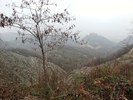Geology
In these areas, along the valley axes, outcrop rocks formed on an ancient seabed in lower Pliocene – middle Pleistocene age (about 5 to 1 million years ago), here mainly consisting of gray-bluish clay (the so-called “Blue Clays Formation"); arenites in layers of thickness from thin to medium and greenish-gray clays, finely laminated are found sometimes.
Fossils (molluscs) are very common, locally concentrated.
 The most recent portion of such Formation is made, however, of finely laminated clay, particularly rich in organic matter and locally bituminous.
The most recent portion of such Formation is made, however, of finely laminated clay, particularly rich in organic matter and locally bituminous.
In the central portions of the main valleys are found the alluvial terraces (age: Upper Pleistocene, about 126,000 to 11,800 years ago), consisting of the accumulation of sediment transported, reworked and recorded by the rivers.
In these soils, often easily eroded, the smaller rivers network occurs sometimes strongly marked, as in the cases examined by the project.
The portion of the high Po Valley (northern sector of the intervention area) is instead characterized by a sweeter morphology, and is formed from sediments ranging in age from the Upper Pleistocene to current, where coarser deposits (gravel and sand) are arranged first in a range of bodies with a characteristic shape of fan (alluvial fans), then in elongated bodies (current and abandoned riverbeds), interspersed with finer deposits (silt and clay) corresponding to the lower areas (floodplains).
